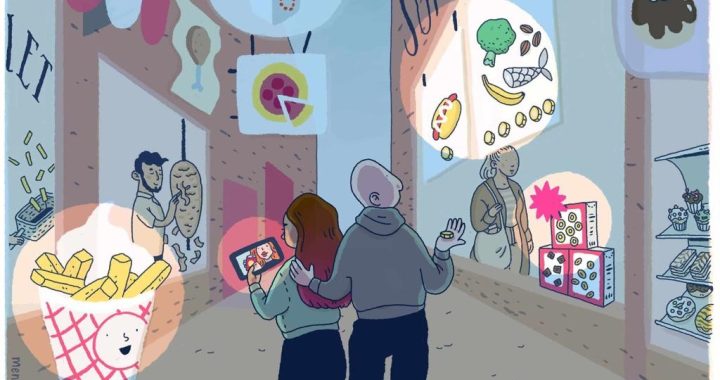Ghana’s current food environment is characterized by a plethora of easily accessible unhealthy foods which negatively impacts the food choices and health of Ghanaians.
Food environments’ is defined by the Food and Agriculture Organization (FAO) “as an interface that mediates one’s food acquisition and consumption with the wider food system, encompassing dimensions such as the availability, accessibility, affordability, desirability, convenience, marketing, and properties of food sources and products”[1].
Fanzo et al.[2]reported that food environments play a significant role in influencing people’s access to unhealthy foods at various locations including households, markets, restaurants, and businesses. This in turn has the potential to contribute to populations’ non-communicable diseases (NCDs)
burden particularly in low and lower-middle-income countries (LMIC), where interventions that ensure healthier food options are often limited[3].
Food environment interventions are often policies and practices aimed at promoting healthy eating while reducing unhealthy foods and can be categorized as environmental or behavioral[4]. Environmental interventions focus on factors that influence a person’s food choice, such as natural and physical, legal and political, and socio-economic and cultural environments while behavioral interventions focus on individuals, with emphasis on their knowledge, attitudes, perceptions, and preferences concerning food choice and consumption[5].
Diet-related non-communicable diseases such as overweight/obesity are a global health concern, particularly in LMIC and Ghana is not an exception[6]. Ghana’s, overweight/obesity numbers have increased from 7.5% in 2008 to 43% in 2016, and is expected to increase by 2025 due to unhealthy food environments. However, efforts to improve food environments in Ghana are often limited 5, [7].
It is therefore of essence that individuals, communities, and the government of Ghana prioritize guidelines to create healthier food environments5. Such guidelines that positively influence dietary choices, nutrition and health outcomes of people while reducing malnutrition, NCDs and their related co-morbidities need to be emphasized to create healthier food environments.
There are various food environment dimensions, identifying and assessing them in any particular setting helps to develop interventions.
In Ghana, in the case of children, studies have identified the promotion, availability and accessibility of unhealthy foods as a dimension of the food environment that need interventions. Laar et al6., recommended that “restricting unhealthy foods in children’s environment and the media, is a major intervention to create a healthier food environment”. Unhealthy food choices are influenced by the marketing of high-energy, nutrient-poor foods. These advertisements have negative impacts on children’s food choices and consumption, leading to rising obesity rates[8]. Jurisdictions such as Norway, Sweden, Australia, Chile etc. that restricted the sale of unhealthy foods to children have seen a reduction in children’s preferences and choices for unhealthy foods[9]. Experts in food environments anticipate a similar reduction in unhealthy foods if Government puts measures to restrict the promotion of unhealthy foods to children in Ghana.
The provision of healthier diets to Ghanaian school-age children is another intervention that needs emphasis[10],[11]. In Ghana, despite issues with poor quality diets in schools with school feeding programs, studies showed school meals have improved diets and nutrition status of school-age children9. Countries such as China, Sweden, Finland, India etc. that had some form of school meals program, led to the improved nutritional status of school-age children[12],[13]. Ghana can achieve similar improvements when more emphasis is laid on healthier food choices among school-aged children through the school feeding program.
Imposing fiscal policies and increasing food-related taxes on unhealthy foods such as sugar-sweetened beverages (SSBs), saturated fatty acids, trans fatty acids, and foods high in nutrients of concern such as sodium, as well as subsiding the affordability of healthy foods would be another intervention component that needs emphasis to create healthier food environments[14],[15]. The cost of these foods is one driving factor of people’s choice[16]. Taxing these foods would increase their prices and discourage purchase, lowering demand for and consumption[17]. Revenues from these taxes can be used to finance healthcare prevention and treatments, and also increase subsidies for healthy foods[18]. Evidence from jurisdictions such as Chile, the Netherlands, South Africa, Hungary, Morocco, Tunisia and many more, that have imposed various forms of taxes on these nutrients of concern have seen reduced demand and consumption resulting in reduced obesity/overweight rates and other diet-related NCDs[19]. Ghana can achieve similar results by implementing these interventions.
Additionally, acting in the food retail sector is a strategic avenue to lead positive changes in the food environment. A recent publication led by a group of researchers from the University of Ghana School of Public Health reported that Accra-based retail stores offer “junk” food more often than healthier options, and retailers reported offering such food because consumers, the youth in particular, request for it[20]. Moreover, Low-income communities often have fewer supermarkets with limited actions for improving grocery stores’ capacity to provide nutritious foods[21]. Policy actions/ interventions that are aimed at improving the food retail environment can increase access to healthier food choices and promote healthier dietary habits among nearby living population[22]. Such interventions may include point-of-purchase nutrition information, product placement, in-store advertisement of healthier food, nudging etc5. These interventions would increase availability, variety, and convenience, reduce the pricing of healthy food and eventually promote healthy eating.
Therefore, individual, and community efforts, and effective government policies, are needed to improve the healthiness of our food environment and dietary habits, thereby reducing the soaring levels of overweight/obesity, and diet-related NCDs in Ghana.
This commentary was written by Baki Ibrahim, Silver Nenema and Amos Laar
The sources cited can be found below
[1] Food and Agriculture Organisation of the United Nations – FAO (2016) Influencing food environments for healthy diets, Rome, Available at: http:// www.fao.org/3/a-i6484e.pdf
[2] Fanzo, J., Arabi, M., Burlingame, B., Haddad, L., Kimenju, S., Miller, G., … & Sinha, D. (2017). Nutrition and food systems. A report by the High Level Panel of Experts on Food Security and Nutrition of the Committee on World Food Security.
[3] Lachat, C., Otchere, S., Roberfroid, D., Abdulai, A., Seret, F. M. A., Milesevic, J., … & Kolsteren, P. (2013). Diet and physical activity for the prevention of noncommunicable diseases in low-and middle-income countries: a systematic policy review. PLoS medicine, 10(6), e1001465.
[4] Swinburn, B., Vandevijvere, S., Kraak, V., Sacks, G., Snowdon, W., Hawkes, C., … & INFORMAS. (2013). Monitoring and benchmarking government policies and actions to improve the healthiness of food environments: a proposed G overnment H ealthy F ood E nvironment P olicy I ndex. Obesity reviews, 14, 24-37.
[5] Roberto, C. A., Swinburn, B., Hawkes, C., Huang, T. T., Costa, S. A., Ashe, M., … & Brownell, K. D. (2015). Patchy progress on obesity prevention: emerging examples, entrenched barriers, and new thinking. The Lancet, 385(9985), 2400-2409.
[6] Laar, A., Barnes, A., Aryeetey, R., Tandoh, A., Bash, K., Mensah, K., Zotor, F., Vandevijvere, S., & Holdsworth, M. (2020). Implementation of healthy food environment policies to prevent nutrition-related non-communicable diseases in Ghana: National experts’ assessment of government action. Food policy, 93, 101907. https://doi.org/10.1016/j.foodpol.2020.101907
[7] Ghana Statistical Service (GSS) GHSG, and ICF International. Ghana Demographic Health Survey 2014. Demographic and Health Survey 2014, 530. (2015). Available online at: https://dhsprogram.com/pubs/pdf/FR307/FR307.pdf (accessed March 21, 2023).
[8] Amevinya, G. S., Vandevijvere, S., Kelly, B., Afagbedzi, S. K., Aryeetey, R., Adjei, A. P., … & Laar, A. (2022). Advertising of unhealthy foods and beverages around primary and junior high schools in Ghana’s most urbanized and populous region. Frontiers in Public Health, 10.
[9] Jensen, M. L. (2020). Screen Time, Television Food and Beverage Advertising, and Dietary Intake in Chilean Preschool and Adolescent Children (Doctoral dissertation, The University of North Carolina at Chapel Hill).
[10] Annan, R. A., Agyapong, N. A. F., Apprey, C. & Aryeetey, R. (2022). Review of Ghana’s Food Environment: Drivers of Availability, Barriers to Healthy Food Access and Impact Interventions and Policies, African Journal of Food, Agriculture, Nutrition and Development, 22(2): 19658 – 19701. DOI: 10.18697/ajfand.107.21820.
[11] Laar, A. K., Addo, P., Aryeetey, R., Agyemang, C., Zotor, F., Asiki, G., Rampalli, K. K., Amevinya, G. S., Tandoh, A., Nanema, S., Adjei, A. P., Laar, M. E., Mensah, K., Laryea, D., Sellen, D., Vandevijvere, S., Turner, C., Osei-Kwasi, H., Spires, M., Blake, C., … Holdsworth, M. (2022). Perspective: Food Environment Research Priorities for Africa-Lessons from the Africa Food Environment Research Network. Advances in nutrition (Bethesda, Md.), 13(3), 739–747. https://doi.org/10.1093/advances/nmac019
[12] Huang, Z., Gao, R., Bawuerjiang, N., Zhang, Y., Huang, X., & Cai, M. (2017). Food and nutrients intake in the school lunch program among school children in Shanghai, China. Nutrients, 9(6), 582.
[13] Juniusdottir, R., Hörnell, A., Gunnarsdottir, I., Lagstrom, H., Waling, M., Olsson, C., … & Olafsdottir, A. S. (2018). Composition of school meals in Sweden, Finland, and Iceland: Official guidelines and comparison with practice and availability. Journal of School Health, 88(10), 744-753
[14] Laar, A. (2022). Health costs and deaths linked to diet-related Non-Communicable Diseases mount. Retrieved from https://www.myjoyonline.com/amos-laar-health-costs-and-deaths-linked-to-diet-related-non-communicable-diseases-mount/
[15] Crino, M. A. (2017). Food environment interventions to address obesity and related non-communicable diseases in Australia (Doctoral dissertation).
[16] Djojosoeparto, S. K., Kamphuis, C., Vandevijvere, S., & Poelman, M. P. (2022). How can national government policies improve food environments in the Netherlands?. International Journal of Public Health, 11.
[17] Allcott, Hunt, Benjamin B. Lockwood, and Dmitry Taubinsky. 2019. “Should We Tax Sugar-Sweetened Beverages? An Overview of Theory and Evidence.” Journal of Economic Perspectives, 33 (3): 202-27.
[18] Mozaffarian, D., Angell, S. Y., Lang, T., & Rivera, J. A. (2018). Role of government policy in nutrition—barriers to and opportunities for healthier eating. Bmj, 361
[19] WHO, 2019. Retrieved from https://apps.who.int/iris/bitstream/handle/10665/329757/WHO-UHC-HGF-PolicyBrief-19.7-eng.pdf?sequence=1&isAllowed=y
[20] Nanema, S., Adjei, A., Amevinya, G. S., & Laar, A. (2022). “Some are healthy and others not”
Characterization of vended food products by Accra-based food retailers. Frontiers in Public Health, 10.
https://doi.org/10.3389/fpubh.2022.941919
[21] Healthy People 2020: Access to Foods that Support Healthy Eating Patterns. Office of Disease Prevention and Health Promotion Website. [(accessed on 21 March 2023)]; Available online: https://www.healthypeople.gov/2020/topics-objectives/topic/social-determinants-health/interventions-resources/access-to-foods-that-support-healthy-eating-patterns
[22] Glanz, K., & Yaroch, A. L. (2004). Strategies for increasing fruit and vegetable intake in grocery stores and communities: policy, pricing, and environmental change. Preventive medicine, 39, 75-80.



